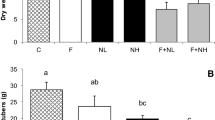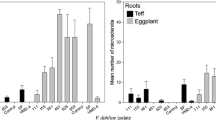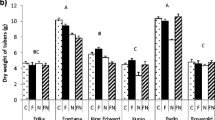Abstract
Laboratory and field studies with the Russet Burbank (RB) potato provide evidence for synergism betweenErwinia carotovora var. atroseptica (Ea) andFusarium roseunt ‘Sambucinum’ (Fs). When these pathogens were inoculated together, the severity of tuber rot was significantly greater than when either pathogen was inoculated separately. Similarly, these pathogens interacted to reduce yield. When both organisms were uniformly applied to puncture wounds on potato seed (inoculum suspension consisted of 108 cells/ml Ea and 105 cells/ml Fs), the total yield was reduced by 46% and U.S. #1 yield by 53%. These reductions occurred even though blackleg symptoms (caused by Ea) were negligible (< 1%). In contrast, inoculations withErwinia carotovora var.carotovora (Ec) and Fs did not interact to reduce potato yield. Potato yields were also not influenced when these pathogens (Ea, Ec, Fs) were separately inoculated.Verticillium wilt (Verticillium dahliae) was significantly less when tubers were inoculated with either Ea, Ec, Fs, Ea + Fs, or Ec + Fs than with uninoculated tubers.
Similar content being viewed by others
Literature Cited
Abo-el-Dahab, M.K., M.A. Ed-Goorany, and M.H. El-Masry. 1978. Association ofEr- winia carotovora var.carotovora andPythium butleri in causing blackleg symptoms on potato stems. Third Inter Congress of Plant Pathol, Münich, p. 77.
Blodgett, E.C. 1947. Comments on black rot, a storage disease of potatoes in Idaho. Plant Dis Rept31:10–13,
Butterfield, E.J. and J.E. DeVay. 1977. Reassessment of soil assays for Verticillium dahliae. Phytopathology 67:1073–1078.
Davis, J.R. 1973. Seed and soil treatments for control of rhizoctonia and blackleg of potato. Plant Dis Rept 57:803–806.
Davis, J.R., Anka Walther-Andrews, and M.N. Howard. 1977. A new method for assayingVerticillium dahliae infection in potato and evaluating resistance among potato cultivars. Proc Am Phytopathol Soc (Abstr), p. 204.
Dye, D.W. 1968. A taxonomic study of the genusErwinia. I.The“amylovora”group. NZJ Sci 11:590–607.
King. E.O., M.K. Ward, and D.E. Raney. 1954. Two simple media for the demonstration of pyocyanin and fluorescin. J Lab Clin Med 44:301–307.
Kirkland, J.L. and M.L. Powelson. 1981. The influence of pathogen interactions on apparent infection rates in potatoes with “early dying” disease (Abstr). Phytopathology 71:886.
Logan, C. and R.B. Copeland. 1979. The effect of time of planting inoculated tubers on the incidence of potato blackleg and gangrene. Ann Appl Biol 93:133–140.
Miller, T.D. and M.N. Schroth. 1972. Monitoring the epiphytic population ofErwinia amylovora on pear with a selective medium. Phytopathology 62:1175–1182.
Molina, J.J. and M.D. Harrison. 1977. The role ofErwinia carotovora in the epidemiology of potato blackleg. I. Relationship ofE. carotovora var.carotovora andE. carotovora var.atroseptica to potato blackleg in Colorado. Am Potato J 54:587–591.
Munzert, Von M., J. Duben, and E. Langerfeld. 1977. On the influence of fungal and bacterial tuber rot pathogens on emergence diseases in the potato crop. Nachrichtenblatt des Deutschen Pfanzenschutzdienstes 29:69–74.
Nielsen, L.W. 1949. Fusarium seedpiece decay of potatoes in Idaho and its relation to blackleg. Agr Exp Sta of the Univ of Idaho, Moscow. Res Bull No. 15, 31 pp.
Perombelon, M.C.M. and A. Kelman. 1980. Ecology of the soft rotErwinias. Ann Rev Phytopathol 18:361–387.
Rahimian, M.K. and J.E. Mitchell. 1981. The colonization of potato stems byErwinia carotovora subsp.carotovora andVerticillium dahliae (Abstr). Phytopathology 71:901.
Sorensen, L.H. and W.C. Sparks. 1980. A method for determining the bruise resistance of potatoes (Abstr). Am Potato J 57:494.
Stanghellini, M.E. and J.D. Russell. 1971. Induction of bacterial seedpiece decay of potatoes by various soil-borne fungi (Abstr). Phytopathology61:1324.
Stewart, D.J. 1962. A selective-diagnostic medium for the isolation of pectinolytic organisms in theEnterobacteriaceae. Nature 195:1023.
Zink, R.T. and Gary A. Secor. 1979. The presence of fungal wilt pathogens increases the incidence of potato blackleg (Abstr). Am Potato J 56:487.
Zink, R.T. and G.A. Secor. 1982. Interactions of fungal wilt pathogens and potato blackleg. Plant Dis Rept 66:1053–1056.
Author information
Authors and Affiliations
Additional information
Published with the approval of the Director of the Idaho Agric. Expt. Stn. as Research Paper No. 82714.
Rights and permissions
About this article
Cite this article
Davis, J.R., Sorensen, L.H. & Corsini, G.S. Interaction ofErwinia spp. andFusarium roseum ‘Sambucinum’ on the Russet Burbank potato. American Potato Journal 60, 409–421 (1983). https://doi.org/10.1007/BF02877247
Received:
Issue Date:
DOI: https://doi.org/10.1007/BF02877247




